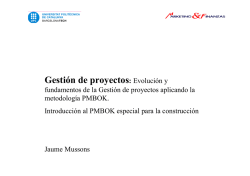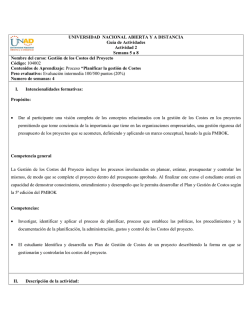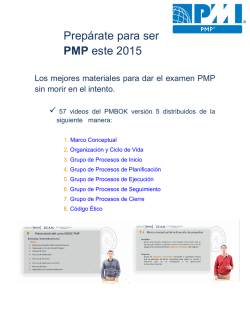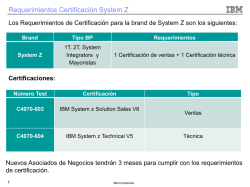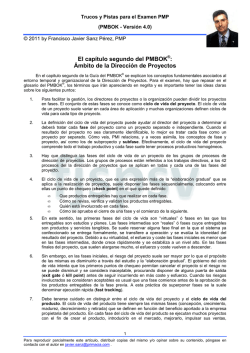
FACULTAD DE INGENIERÍA
FACULTAD INGENIERÍA DE CARRERA DE INGENIERÍA CIVIL “OPTIMIZACIÓN DE LA GESTIÓN Y DIRECCIÓN DE LA CONSTRUCCIÓN DEL TRAMO III DEL ACCESO PRINCIPAL AL PROYECTO CONGA APLICANDO METODOLOGÍA DE LOS ESTÁNDARES DEL PMBOK y LAST PLANNER SYSTEM, 2014” Tesis para optar el título profesional de: Ingeniero Civil Autor: Aurea Lorena Díaz Chávez Asesor: Mag. Ing. Hugo Miranda Tejada Cajamarca – Perú 2015 OPTIMIZACIÓN DE LA GESTIÓN Y DIRECCIÓN DE LA CONSTRUCCIÓN DEL TRAMO III DEL ACCESO PRINCIPAL AL PROYECTO CONGA APLICANDO METODOLOGÍA DE LOS ESTÁNDARES DEL PMBOK y LAST PLANNER SYSTEM, 2014 ÍNDICE DE CONTENIDOS CAPÍTULO 1. INTRODUCCIÓN ................................................................................................1 1.1. Realidad problemática........................................................................................................1 1.2. Formulación del problema ..................................................................................................2 1.3. Justificación .......................................................................................................................2 1.4. Limitaciones .......................................................................................................................3 1.5. Objetivos............................................................................................................................3 1.5.1. Objetivo General .................................................................................................3 1.5.2. Objetivos Específicos ..........................................................................................3 CAPÍTULO 2. MARCO TEÓRICO..............................................................................................4 2.1. Antecedentes .....................................................................................................................4 2.1.1. Proyectos en donde se ha aplicado los estándares del PMBOK:..........................4 2.1.2. Proyectos en los que se ha aplicado la filosofía de Lean Construction: ................5 2.2. Bases Teóricas ..................................................................................................................7 2.2.1. La Práctica Actual en la Construcción Peruana....................................................7 2.2.2. ¿Qué es el Project Management Institute? ..........................................................8 2.2.3. ¿Qué es el PMBOK? ...........................................................................................9 2.2.4. ¿Qué es un Proyecto? ....................................................................................... 11 2.2.5. ¿Qué es la Dirección de un Proyecto? ............................................................... 12 2.2.6. Gestión de un Proyecto aplicando Metodología de los Estándares del PMBOK . 16 2.2.6.1. Iniciación ....................................................................................... 16 2.2.6.2. Planificación .................................................................................. 18 2.2.6.3. Ejecución ....................................................................................... 25 A. Desarrollar el Equipo del Proyecto ................................................. 25 B. Dirigir el Equipo del Proyecto ........................................................................................... 26 2.2.6.4. Seguimiento y Control.................................................................... 27 2.2.6.5. Cierre ............................................................................................ 32 2.2.7. ¿Qué es el Lean Construction? ......................................................................... 33 2.2.7.1. Principios del Lean Construction .................................................... 35 2.2.7.2. Last Planner System (LPS) o Sistema del Último Planificador ........ 35 2.2.8. Definición de términos básicos. ......................................................................... 42 CAPÍTULO 3. HIPÓTESIS ....................................................................................................... 44 3.1 Formulación de la hipótesis .............................................................................................. 44 3.2 Variables.......................................................................................................................... 44 3.3 Operacionalización de variables ....................................................................................... 44 CAPÍTULO 4. PRODUCTO DE APLICACIÓN PROFESIONAL ............................................... 46 4.1. Ubicación Geográfica del Proyecto ................................................................................... 46 4.2. Descripción del Proyecto .................................................................................................. 46 4.3. Procedimiento .................................................................................................................. 47 4.3.1. Etapa I: Inicio .................................................................................................... 48 4.3.1.1. Acta de Constitución del Proyecto.................................................. 48 4.3.1.2. Registro de Interesados del Proyecto............................................. 56 Díaz Chávez Aurea Lorena v OPTIMIZACIÓN DE LA GESTIÓN Y DIRECCIÓN DE LA CONSTRUCCIÓN DEL TRAMO III DEL ACCESO PRINCIPAL AL PROYECTO CONGA APLICANDO METODOLOGÍA DE LOS ESTÁNDARES DEL PMBOK y LAST PLANNER SYSTEM, 2014 4.3.1. a. Etapa II: Planificación ........................................................................................ 57 4.3.1.1. Plan para la Dirección del Proyecto................................................ 57 4.3.1.2. Planificar la Gestión del Alcance .................................................... 60 Trabajos Preliminares ...................................................................................................... 65 4.3.1.3. Planificar la Gestión del Tiempo ..................................................... 70 4.3.1.4. Planificar la Gestión de Costos ...................................................... 80 4.3.1.5. Planificar la Gestión de la Calidad .................................................. 89 4.3.1.6. Planificar Gestión de Recursos Humanos ...................................... 96 4.3.1.7. Planificar la Gestión de Comunicaciones ..................................... 111 4.3.1.8. Planificar la Gestión de Riesgos................................................... 114 4.3.1.9. Planificar la Gestión de Adquisiciones .......................................... 122 4.3.1.1. Planificar la Gestión de los Interesados........................................ 125 4.3.2. Etapa III: Ejecución.......................................................................................... 127 4.3.3. Etapa IV: Seguimiento y Control ...................................................................... 134 4.3.3.1. Gestión del Valor Ganado ............................................................ 137 4.3.4. Etapa V: Cierre ................................................................................................ 143 CAPÍTULO 5. MATERIALES Y MÉTODOS ........................................................................... 144 5.1 Tipo de diseño de investigación...................................................................................... 144 5.2 Material de estudio. ........................................................................................................ 144 5.2.1 Unidad de estudio............................................................................................ 144 5.2.2 Población. ....................................................................................................... 144 5.2.3 Muestra. .......................................................................................................... 144 5.3 Técnicas, procedimientos e instrumentos. ...................................................................... 144 5.3.1 Para recolectar datos. ..................................................................................... 144 5.3.2 Para analizar información. ............................................................................... 145 CAPÍTULO 6. RESULTADOS................................................................................................ 146 6.1. Etapa I: Inicio ................................................................................................................. 146 6.2. Etapa II: Planificación ..................................................................................................... 146 6.3. Etapa III: Ejecución ........................................................................................................ 147 6.4. Etapa IV: Seguimiento y Control ..................................................................................... 147 6.4.1. Alcance ........................................................................................................... 147 6.4.2. Tiempo ............................................................................................................ 147 6.4.3. Costo .............................................................................................................. 148 6.4.4. Mediciones de Desempeño del Proyecto ......................................................... 149 6.4.4.1. Índice de Desempeño del Cronograma (SPI) ............................... 149 6.4.4.2. Índice de Desempeño del Costo (CPI) ......................................... 150 6.5. Prueba de Hipótesis ....................................................................................................... 151 CAPÍTULO 7. DISCUSIÓN .................................................................................................... 152 CAPÍTULO 8. CONCLUSIONES ........................................................................................... 153 CAPÍTULO 9. RECOMENDACIONES ................................................................................... 154 REFERENCIAS ......................................................................................................................... 155 Díaz Chávez Aurea Lorena vi OPTIMIZACIÓN DE LA GESTIÓN Y DIRECCIÓN DE LA CONSTRUCCIÓN DEL TRAMO III DEL ACCESO PRINCIPAL AL PROYECTO CONGA APLICANDO METODOLOGÍA DE LOS ESTÁNDARES DEL PMBOK y LAST PLANNER SYSTEM, 2014 RESUMEN El presente trabajo de investigación se llevó a cabo en el proyecto: “Construcción del Tramo III del Acceso Principal al Proyecto Conga”, ubicado entre los distritos de Huasmín y Sorochuco, Provincia de Celendín y La Encañada, Provincia de Cajamarca, Departamento de Cajamarca – Perú, realizada en el año 2014, donde se aplicó metodología de los estándares del PMBOK y Last Planner System, reconocidos a nivel mundial. Este estudio corresponde a una investigación No Experimental Transeccional Descriptiva y la recolección de datos tuvo dos escenarios, no en gabinete y otro en obra mediante Fuentes Primarias. Para la implementación de la metodología, la supervisión del Área de Construcción del Proyecto Conga ha aplicado los estándares del PMBOK y Last Planner System en el inicio, planificación, ejecución, seguimiento y control y cierre del proyecto. En la etapa de Inicio del Proyecto se realizó el alcance del proyecto y se definieron los interesados. En la etapa de Planificación se elaboraron diferentes planes de Dirección para el desarrollo del proyecto, se definió el Cronograma y el Presupuesto. Durante la Etapa de Ejecución y Seguimiento y Control se empleó la herramienta de Gestión del Valor Ganado y se insertó Last Planner System para la programación de trabajos semana a semana. Concluyendo que la aplicación los estándares del PMBOK y Last Planner System optimizan la gestión y dirección de proyectos y se asegura el cumplimiento del Presupuesto aprobado y del Cronograma planificado teniendo como Indicadores de Estado del proyecto: CPI y SPI. Díaz Chávez Aurea Lorena xii OPTIMIZACIÓN DE LA GESTIÓN Y DIRECCIÓN DE LA CONSTRUCCIÓN DEL TRAMO III DEL ACCESO PRINCIPAL AL PROYECTO CONGA APLICANDO METODOLOGÍA DE LOS ESTÁNDARES DEL PMBOK y LAST PLANNER SYSTEM, 2014 ABSTRACT This research was conducted in the project: "Construction of Section III of the Main Access to Conga’s Project," located between the districts of Huasmín and Sorochuco, Province Celendín and Encañada, Province of Cajamarca, Department of Cajamarca - Peru, held in 2014, where methodology and standards PMBOK Last Planner System, recognized globally applied. This study is a no experimental research transectional Descriptive and data collection had two scenarios, one in cabinet and another on site with Primary Sources. For the implementation of the methodology, supervision of the construction area of Conga’s Project has applied standards PMBOK and Last Planner System in initiating, planning, executing, monitoring and control and project closure. In the Project Initiation stage the scope of the project was conducted and stakeholders were defined. In the planning stage direction different plans for the project were developed, it defined the schedule and budget. During the implementation phase, monitoring and control tool Earned Value Management is used and inserted Last Planner System for scheduling jobs every week. Concluding that the application standards PMBOK Last Planner System and optimize the management and direction of projects and compliance with the approved budget and schedule as planned taking Status Indicators project ensures: CPI and SPI. Díaz Chávez Aurea Lorena xiii NOTA DE ACCESO No se puede acceder al texto completo pues contiene datos confidenciales OPTIMIZACIÓN DE LA GESTIÓN Y DIRECCIÓN DE LA CONSTRUCCIÓN DEL TRAMO III DEL ACCESO PRINCIPAL AL PROYECTO CONGA APLICANDO METODOLOGÍA DE LOS ESTÁNDARES DEL PMBOK y LAST PLANNER SYSTEM, 2014 REFERENCIAS 1. BALLARD, G. (2000). The Last Planner System of Production Control. Faculty of Engineering of the University of Birminghan. 2. BULEJE REVILLA, K. (2012). Productividad en la Construcción de un condominio aplicando conceptos de la Filosofía Lean Construction. Lima: UPCP. 3. ESPEJO FERNÁNDEZ, A., & VÉLIZ FLORES, J. (2013). APLICACIÓN DE LA EXTENSIÓN PARA LA CONSTRUCCIÓN DE LA GUÍA DEL PMBOK - TERCERA EDICIÓN, EN LA GERENCIA DE PROYECTO DE UNA PRESA DE RELAVES EN LA UNIDAD OPERATIVA ARCATA - AREQUIPA. Lima: PUCP. 4. HIDALGO RAMÍREZ, P. (2013). MODELO DE GESTIÓN Y ADMINISTRACIÓN DE PROYECTOS OPERACIONALES. Santiago de Chile: Universidad de Chile. 5. IBARRA GÓMEZ, L. (2011). LEAN CONSTRUCTION. México DF: UNAM. 6. LLEDÓ, P. (2013). ADMINISTRACIÓN DE PROYECTOS: El ABC para un Director de Proyectos Exitoso 3ra. Edición. Canadá: Pablo Lledó. 7. LUENGAS ZUÑIGA, C. (2011). Implementación y seguimiento de la Metodología Lean Construction a las Actividades Constructivas de la Obra Metropolitan Business Park en la empresa Marval S.A. Bucaramanga: Universidad Pontificia Bolivariana. 8. MIRANDA CASANOVA, D. (2012). Implementación del Sistema Last Planner en una Habilitación Urbana. Lima: PUCP. 9. OLSINA, C., & GARAY, M. (2013). APLICACIÓN DE PRÁCTICAS PMI EN PROYECTOS DE CONSTRUCCIÓN. VI Jornadas Cuyanas de Project Management. Nuevo Cuyo Argentina. 10. PONS ACHELL, J. (2014). INTRODUCCIÓN A LEAN CONSTRUCTION. Madrid: Fundación Laboral de la Construcción. 11. PMI (2013). Guía de los Fundamentos para la Dirección de Proyectos (Guía del PMBOK) Quinta Edición. Pensilvania, EE.UU: Project Management Institute Inc. Díaz Chávez Aurea Lorena Pág. 155
© Copyright 2024
